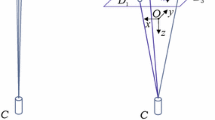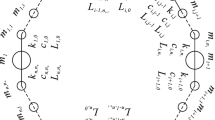Abstract
This paper discusses relative equilibria (or steady motions) and their stability for the dynamics of the system of two spring-connected masses in a central gravitational field. The system can be regarded as a simplified model for the Tethered Satellite System (TSS), where the tether is modeled by a (linear or nonlinear) spring. In the previous studies of the TSS problem, it was typically assumed that the center of mass is located at the massive one of the two end-masses, and moves on a great-circle orbit. However, for the simple system treated in this paper, it is proved that nongreat-circle relative equilibria do exist. Some fundamental concepts of the dynamics of an arbitrary assembly moving in a central gravitational field are discussed. The notion of steady motions used in engineering literature is linked with the notion of relative equilibria in geometric mechanics. Numerical computations show some interesting nongreat-circle relative equilibria for the spring-connected system. Radial relative equilibria, which correspond to the station-keeping mode for TSS, are then introduced. Within the framework of symmetry and reduction, their stability properties are investigated by adopting the reduced energy-momentum method, which takes the advantage of the intrinsic symmetry structure. It is shown that for practical configurations, the system at radial relative equilibria is stable if some conditions are satisfied.
Similar content being viewed by others
References
Aboelnaga M. Z. and Barkin Y. V.: 1979, Stationary motion of a rigid body in the field of attraction of a sphere.Astron. J., Acad. Sci., USSR.56, 881–887.
Abraham, R. and Marsden, J. E.: 1978,Foundations of Mechanics. Benjamin/Cummings Reading, 2nd edition, 1978.
Arnold, D. A.: 1987, The behavior of long tethers in space.J. of the Astron. Sciences,35, 3–18.
Bainum, P. M., Bekey, I., Guerriero, L., and Penzo, P. A., editors: 1987,Tethers in Space. American Astronautical Society. Volume 62, Advances in the Astronautical Sciences.
Bainum, P. M. and Evans, K. S.: 1974, Three-dimensional motion and stability of two rotating cable-connected bodies.J. Spacecraft,12, 242–250.
Barkin, Y. V.: 1985, ‘Oblique’ regular motions of a satellite and some small effects in the motions of the moon and phobos.Kosmicheskie Issledovaniya,23, 26–36.
Bekey, I.: 1987, Historical evolution of tethers in space. In P. M. Bainum, I. Bekey, L. Guerriero, and P. A. Penzo, editors,Tethers in Space. American Astronautical Society.
Beletskii, V. V. and Levin, E. M.: 1981, Mechanics of an orbital cable system.Kosmicheskie Issledovaniya, pgs. 486–494.
Beletskii, V. V. and Levin, E. M.: 1985, Dynamics of the orbital cable system.Acta Astronautica,12, 285–291.
Beletskii, V. V. and Levin, E. M.: 1991, Dynamics of space systems including elastic tethers. InDynamical Problems of Rigid-Elastic Systems and Structures, pgs. 17–26. Springer-Verlag, May 1991. IUTAM Symposium Moscow.
Breakwell, J. V. and Janssens, F. L.: 1992, On the transverse vibrations of a revolving tether.Celestial Mechanics and Dynamical Astronomy,54, 317–341.
Colombo, G., Gaposchikin, E., Grossi, M., and Weiffenbach, G.: 1974, Shuttle-borne skyhook: A new tool for low-orbital-attitude research. Technical report, SAO Report, September 1974.
Crist, S. A. and Eisley, J. G.: 1970, Cable motion of a spinning spring-mass system in orbit.J. Spacecraft,7, 1352–1357, November 1970.
de Matteis, G. and de Socio, L. M.: 1990, Equilibrium of a tether-subsatellite system.Eur. J. Mech., A/Solids,9, 207–224.
Goldstein, H.: 1980,Classical Mechanics, Addison-Wesley Publishing Company, Inc., 2nd edition, 1980.
Levin, E. M.: 1983, Stability of the time-independent tehtered motions of two bodies in orbit under the action of gravitational and aerodynamic forces.Kosmicheskie Issledovaniya, pgs. 544–551.
Liaw, D. C. and Abed, E. H.: 1990, Stabilization of tethered satellites during station keeping.IEEE Trans. on Automatic Control,35, 1186–1196, November 1990.
Liu, L. D. and Bainum, P. M.: 1988, Effect of tether flexibility on the tethered shuttle sub-satellite stability and control.J. Guidance, Control, and Dynamics,12, 866–873.
Marion, J. B. and Thornton, S. T.: 1988,Classical Dynamics of Particles and Systems. Harcourt Brace Jovanovich, 3rd edition.
Misra, A. K. and Modi, V. J.: 1987, A survey on the dynamics and control of tethered satellite systems. In P. M. Bainum, I. Bekey, L. Guerriero, and P. A. Penzo, editors,Tethers in Space. American Astronautical Society.
Moravec, H.: 1977, A non-synchronous orbital skyhook.J. of the Astron. Sciences,25, 307–322.
Palais, R. S.: 1979, The principle of symmetric criticality.Comm. in Math. Physics,69, 19–30.
Pasca, M., Pignataro, M., and Luongo, A.: 1991, Three-dimensional vibrations of tethered satellite systems.J. Guidance, Control, and Dynamics,14, 312–320, Mar.–Ap., 1991.
Pearson, J.: 1975, The orbital tower: a spacecraft launcher using the earth's rotational energy.Acta Astronautica,2, 785–799.
Penzo, P. A. and Ammann, P. W., editors: 1989,Tethers in Space Handbook. NASA, 2 edition, 1989.
Rimrott, F. P. J.: 1989,Introductory Attitude Dynamics, Springer-Verlag, New York.
Simo, J. C., Lewis, D. and Marsden, J. E.: 1991, Stability of relative equilibria, Part I: The reduced energy-momentum method.Archive for Rational Mechanics and Analysis,115, 15–59.
Simo, J. C., Posbergh, T., and Marsden, J. E.: 1991, Stability of relative equilibria, Part II: Application to nonlinear elasticity.Archive for Rational Mechanics and Analysis,115, 61–100.
Wang, L.-S., Chern, S.-J., and Shih, C.-W.: 1994, On the dynamics of a tethered satellite system.Archive for Rational Mechanics and Analysis,127, 297–318.
Wang, L.-S. and Krishnaprasad, P. S.: 1992, Gyroscopic control and stabilization.J. of Nonlinear Sciences,2, 367–415.
Wang, L.-S. and Krishnaprasad, P. S.: 1989, Relative equilibria of two rigid bodies connected by a ball-in-socket joint.Proc. of the 1989 IEEE Conference on Decision and Control, pgs. 692–697, Dec. 1989.
Wang, L.-S., Krishnaprasad, P. S., and Maddocks, J. H.: 1991, Hamiltonian dynamics of a rigid body in a central gravitational field.Celestial Mechanics and Dynamical Astronomy,50, 349–386.
Wang, L.-S., Maddocks, J. H., and Krishnaprasad, P. S.: 1992, Steady rigid-body motions in a central gravitational field.J. of the Astron. Sciences,40, 449–478.
Author information
Authors and Affiliations
Additional information
This work was partially supported by the National Science Council, Republic of China, under grant NSC-83-0208-M-002-082. The authors would like to thank W.-T. Chou for some computational assistance.
Rights and permissions
About this article
Cite this article
Wang, LS., Cheng, SF. Dynamics of two spring-connected masses in orbit. Celestial Mech Dyn Astr 63, 289–312 (1995). https://doi.org/10.1007/BF00692292
Received:
Accepted:
Issue Date:
DOI: https://doi.org/10.1007/BF00692292




